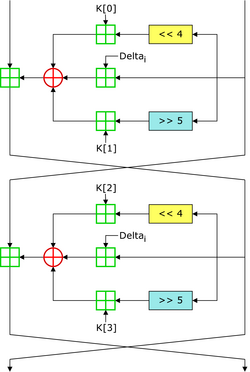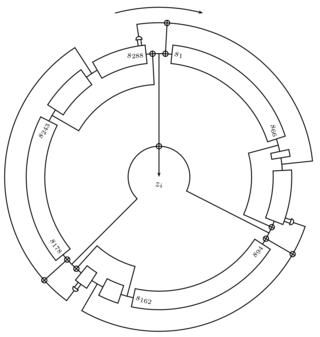Related Research Articles

The Advanced Encryption Standard (AES), also known by its original name Rijndael, is a specification for the encryption of electronic data established by the U.S. National Institute of Standards and Technology (NIST) in 2001.
In cryptography, a block cipher is a deterministic algorithm that operates on fixed-length groups of bits, called blocks. Block ciphers are the elementary building blocks of many cryptographic protocols. They are ubiquitous in the storage and exchange of data, where such data is secured and authenticated via encryption.

The Data Encryption Standard is a symmetric-key algorithm for the encryption of digital data. Although its short key length of 56 bits makes it too insecure for modern applications, it has been highly influential in the advancement of cryptography.

A stream cipher is a symmetric key cipher where plaintext digits are combined with a pseudorandom cipher digit stream (keystream). In a stream cipher, each plaintext digit is encrypted one at a time with the corresponding digit of the keystream, to give a digit of the ciphertext stream. Since encryption of each digit is dependent on the current state of the cipher, it is also known as state cipher. In practice, a digit is typically a bit and the combining operation is an exclusive-or (XOR).

Symmetric-key algorithms are algorithms for cryptography that use the same cryptographic keys for both the encryption of plaintext and the decryption of ciphertext. The keys may be identical, or there may be a simple transformation to go between the two keys. The keys, in practice, represent a shared secret between two or more parties that can be used to maintain a private information link. The requirement that both parties have access to the secret key is one of the main drawbacks of symmetric-key encryption, in comparison to public-key encryption. However, symmetric-key encryption algorithms are usually better for bulk encryption. With exception of the one-time pad they have a smaller key size, which means less storage space and faster transmission. Due to this, asymmetric-key encryption is often used to exchange the secret key for symmetric-key encryption.
Articles related to cryptography include:
In cryptography, Skipjack is a block cipher—an algorithm for encryption—developed by the U.S. National Security Agency (NSA). Initially classified, it was originally intended for use in the controversial Clipper chip. Subsequently, the algorithm was declassified.

The GOST block cipher (Magma), defined in the standard GOST 28147-89, is a Soviet and Russian government standard symmetric key block cipher with a block size of 64 bits. The original standard, published in 1989, did not give the cipher any name, but the most recent revision of the standard, GOST R 34.12-2015, specifies that it may be referred to as Magma. The GOST hash function is based on this cipher. The new standard also specifies a new 128-bit block cipher called Kuznyechik.

In cryptography, the Tiny Encryption Algorithm (TEA) is a block cipher notable for its simplicity of description and implementation, typically a few lines of code. It was designed by David Wheeler and Roger Needham of the Cambridge Computer Laboratory; it was first presented at the Fast Software Encryption workshop in Leuven in 1994, and first published in the proceedings of that workshop.
In cryptography, Camellia is a symmetric key block cipher with a block size of 128 bits and key sizes of 128, 192 and 256 bits. It was jointly developed by Mitsubishi Electric and NTT of Japan. The cipher has been approved for use by the ISO/IEC, the European Union's NESSIE project and the Japanese CRYPTREC project. The cipher has security levels and processing abilities comparable to the Advanced Encryption Standard.
In computer science and cryptography, Whirlpool is a cryptographic hash function. It was designed by Vincent Rijmen and Paulo S. L. M. Barreto, who first described it in 2000.
In cryptography, the eXtended Sparse Linearization (XSL) attack is a method of cryptanalysis for block ciphers. The attack was first published in 2002 by researchers Nicolas Courtois and Josef Pieprzyk. It has caused some controversy as it was claimed to have the potential to break the Advanced Encryption Standard (AES) cipher, also known as Rijndael, faster than an exhaustive search. Since AES is already widely used in commerce and government for the transmission of secret information, finding a technique that can shorten the amount of time it takes to retrieve the secret message without having the key could have wide implications.

Trivium is a synchronous stream cipher designed to provide a flexible trade-off between speed and gate count in hardware, and reasonably efficient software implementation.
CLEFIA is a proprietary block cipher algorithm, developed by Sony. Its name is derived from the French word clef, meaning "key". The block size is 128 bits and the key size can be 128 bit, 192 bit or 256 bit. It is intended to be used in DRM systems. It is among the cryptographic techniques recommended candidate for Japanese government use by CRYPTREC revision in 2013.
The following outline is provided as an overview of and topical guide to cryptography:
This article summarizes publicly known attacks against block ciphers and stream ciphers. Note that there are perhaps attacks that are not publicly known, and not all entries may be up to date.

Speck is a family of lightweight block ciphers publicly released by the National Security Agency (NSA) in June 2013. Speck has been optimized for performance in software implementations, while its sister algorithm, Simon, has been optimized for hardware implementations. Speck is an add–rotate–xor (ARX) cipher.

Simon is a family of lightweight block ciphers publicly released by the National Security Agency (NSA) in June 2013. Simon has been optimized for performance in hardware implementations, while its sister algorithm, Speck, has been optimized for software implementations.
Algebraic Eraser (AE) is an anonymous key agreement protocol that allows two parties, each having an AE public–private key pair, to establish a shared secret over an insecure channel. This shared secret may be directly used as a key, or to derive another key that can then be used to encrypt subsequent communications using a symmetric key cipher. Algebraic Eraser was developed by Iris Anshel, Michael Anshel, Dorian Goldfeld and Stephane Lemieux. SecureRF owns patents covering the protocol and unsuccessfully attempted to standardize the protocol as part of ISO/IEC 29167-20, a standard for securing radio-frequency identification devices and wireless sensor networks.
Prince is a block cipher targeting low latency, unrolled hardware implementations. It is based on the so-called FX construction. Its most notable feature is the alpha reflection: the decryption is the encryption with a related key which is very cheap to compute. Unlike most other "lightweight" ciphers, it has a small number of rounds and the layers constituting a round have low logic depth. As a result, fully unrolled implementation are able to reach much higher frequencies than AES or PRESENT. According to the authors, for the same time constraints and technologies, PRINCE uses 6–7 times less area than PRESENT-80 and 14–15 times less area than AES-128.
References
- ↑ Bogdanov, Andrey; Knudsen, Lars R.; Leander, Gregor; Paar, Christof; Poschmann, Axel; Robshaw, Matthew J. B.; Seurin, Yannick; Vikkelsoe, Charlotte (2007). "PRESENT: An Ultra-Lightweight Block Cipher". Cryptographic Hardware and Embedded Systems - CHES 2007. Lecture Notes in Computer Science. Vol. 4727. pp. 450–466. doi: 10.1007/978-3-540-74735-2_31 . ISBN 978-3-540-74734-5.
- 1 2 Katholieke Universiteit Leuven. "Ultra-lightweight encryption method becomes international standard". Archived from the original on 2013-08-01. Retrieved 2012-02-28.
- 1 2 ISO. "ISO/IEC 29192-2:2019, Information security - Lightweight cryptography - Part 2: Block ciphers" . Retrieved 2020-08-12.
- ↑ Blondeau, Cline; Nyberg, Kaisa (2014). "Links between Truncated Differential and Multidimensional Linear Properties of Block Ciphers and Underlying Attack Complexities". Advances in Cryptology – EUROCRYPT 2014. Lecture Notes in Computer Science. Vol. 8441. pp. 165–182. doi: 10.1007/978-3-642-55220-5_10 . ISBN 978-3-642-55219-9.
- ↑ Lee, Changhoon (2014-01-28). "Biclique cryptanalysis of PRESENT-80 and PRESENT-128". The Journal of Supercomputing. 70 (1): 95–103. doi:10.1007/s11227-014-1103-3. ISSN 0920-8542. S2CID 16627173.
- ↑ Faghihi Sereshgi, Mohammad Hossein; Dakhilalian, Mohammad; Shakiba, Mohsen (2015-10-06). "Biclique cryptanalysis of MIBS-80 and PRESENT-80 block ciphers". Security and Communication Networks. 9: 27–33. doi:10.1002/sec.1375. ISSN 1939-0122.
- ↑ Karthikeyan Bhargavan, Gaëtan Leurent (2016-08-24). "Sweet32: Birthday attacks on 64-bit block ciphers in TLS and OpenVPN" . Retrieved 2016-09-30.
- ↑ Cryptolux. "Lightweight Block Ciphers: PRESENT" . Retrieved 2020-08-12.
- ↑ Dinu, Daniel; Corre, Yann Le; Khovratovich, Dmitry; Perrin, Léo; Großschädl, Johann; Biryukov, Alex (14 July 2018). "Triathlon of lightweight block ciphers for the Internet of things" (PDF). Journal of Cryptographic Engineering. 9 (3): 283–302. doi:10.1007/s13389-018-0193-x. S2CID 1578215.
- ↑ ISO. "ISO/IEC 29167-11:2014, Information technology - Automatic identification and data capture techniques - Part 11: Crypto suite PRESENT-80 security services for air interface communications" . Retrieved 2021-10-29.